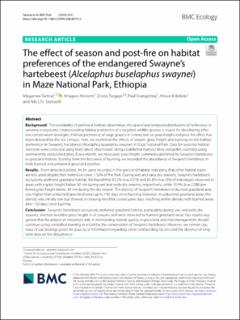| dc.description.abstract | Background: The availability of preferred habitats determines the spatial and temporal distribution of herbivores in savanna ecosystems. Understanding habitat preference of a targeted wildlife species is crucial for developing efective conservation strategies. Habitat preference of large grazers in connection to grass height and post-fre efect has been debated for the last century. Here, we examined the efects of season, grass height and burning on the habitat preference on Swayne’s hartebeest (Alcelaphus buselaphus swaynei) in Maze National Park. Data for seasonal habitat selection were collected using both direct observation along established transect lines and pellet counting using permanently established plots. Every month, we measured grass height commonly preferred by Swayne’s hartebeest in grassland habitat. Starting from the frst week of burning, we recorded the abundance of Swayne’s hartebeest in both burned and unburned grassland patches. Results: From detected pellets, 94.3% were recorded in the grassland habitat indicating that other habitat types are less used despite their extensive cover>50% of the Park. During wet and early dry seasons, Swayne’s hartebeest exclusively preferred grassland habitat. We found that 85.2% (n=1079) and 85.3% (n=593) of individuals observed in areas with a grass height below 30 cm during wet and early-dry seasons, respectively; while 70.9% (n=2288) preferred grass height below 30 cm during the dry season. The density of Swayne’s hartebeest in burned grassland area was higher than unburned grassland areas up to 150 days since burning. However, in unburned grassland areas, the density was initially low but showed increasing trend for consecutive days, reaching similar density with burned areas after 150 days since burning. Conclusion: Swayne’s hartebeest exclusively preferred grassland habitat, particularly during wet and early-dry seasons, shortest available grass height in all seasons and were attracted to burned grassland areas. Our results suggested that fre played an important role in maintaining habitat quality in grassland, and that management should continue using controlled burning as a tool for the conservation of Swayne’s hartebeest. However, we remain cautious of our fndings given the paucity of information regarding other confounding factors and the absence of longterm data on fre disturbance. | en_US |

